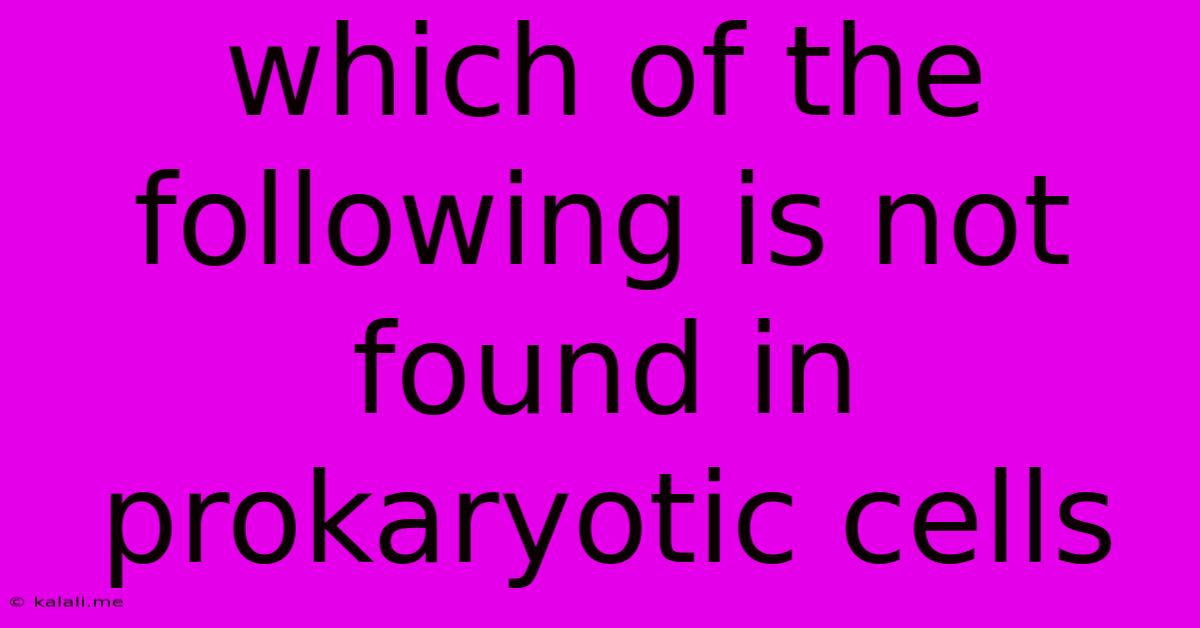Which Of The Following Is Not Found In Prokaryotic Cells
Kalali
Jun 14, 2025 · 3 min read

Table of Contents
Which of the Following is NOT Found in Prokaryotic Cells? A Deep Dive into Cell Structure
Understanding the fundamental differences between prokaryotic and eukaryotic cells is crucial in biology. This article will explore the key distinctions, focusing specifically on structures not found in prokaryotic cells. We'll delve into the defining characteristics of prokaryotes, clarifying the absence of certain organelles and structures commonly found in their eukaryotic counterparts.
Prokaryotic cells, the simpler of the two cell types, lack membrane-bound organelles. This fundamental difference significantly impacts their cellular processes and overall organization. This means that unlike eukaryotic cells, which possess a nucleus and other specialized compartments, prokaryotic cells have their genetic material dispersed within the cytoplasm.
Key Structures Absent in Prokaryotic Cells
Several key structures are notably absent from prokaryotic cells. Let's examine some of the most important:
-
Membrane-bound Organelles: This is perhaps the most defining difference. Prokaryotes lack organelles such as mitochondria (responsible for cellular respiration), chloroplasts (responsible for photosynthesis in plants), the endoplasmic reticulum (involved in protein synthesis and transport), Golgi apparatus (involved in protein modification and packaging), and lysosomes (involved in waste breakdown). All these are enclosed within membranes, a feature absent in prokaryotic cells.
-
Nucleus: The nucleus, which houses the cell's genetic material (DNA) in eukaryotes, is absent in prokaryotes. Instead, the prokaryotic DNA is found in a region called the nucleoid, which is not membrane-enclosed. This lack of a defined nucleus impacts how genetic information is organized and accessed.
-
Complex Cytoskeleton: While prokaryotes possess some cytoskeletal elements, they lack the complex and highly organized cytoskeleton found in eukaryotes. This intricate network of protein filaments is essential for maintaining cell shape, facilitating intracellular transport, and enabling cell division in eukaryotic cells. Prokaryotic cytoskeletal elements are simpler and serve more basic functions.
-
Endomembrane System: The intricate network of interconnected membranes comprising the endoplasmic reticulum and Golgi apparatus—the endomembrane system—is completely absent in prokaryotes. This system is crucial for protein synthesis, modification, and transport in eukaryotes.
-
Large Ribosomes: While both prokaryotic and eukaryotic cells possess ribosomes (responsible for protein synthesis), prokaryotic ribosomes are smaller (70S) than their eukaryotic counterparts (80S). This difference is significant and is exploited in certain antibiotics that target prokaryotic ribosomes without harming eukaryotic ribosomes.
Understanding the Implications
The absence of these structures directly impacts the capabilities and limitations of prokaryotic cells. Their simpler structure means they generally have less specialized functions and rely on more direct mechanisms for cellular processes. Their smaller size and lack of internal compartmentalization influence their metabolic efficiency and overall life strategies.
Common Misconceptions
It's important to clarify that prokaryotic cells do contain essential structures like the plasma membrane (cell membrane), cytoplasm, ribosomes, and DNA. However, the organization and complexity of these structures differ significantly from those found in eukaryotic cells. The absence of membrane-bound organelles is the defining characteristic.
In conclusion, the key structures not found in prokaryotic cells include membrane-bound organelles, a nucleus, a complex cytoskeleton, an endomembrane system, and large 80S ribosomes. Understanding these differences is fundamental to grasping the diversity and complexity of life on Earth. Further research into cellular biology will continue to reveal more nuanced insights into the fascinating world of prokaryotic and eukaryotic cells.
Latest Posts
Latest Posts
-
How To Be A Mature Man
Jun 14, 2025
-
How Many Electrons Does Uranium 235 Have
Jun 14, 2025
-
What Part Of Speech Is Happy
Jun 14, 2025
-
Shortcut Key For Save As In Word
Jun 14, 2025
-
Value Of K In Coulombs Law
Jun 14, 2025
Related Post
Thank you for visiting our website which covers about Which Of The Following Is Not Found In Prokaryotic Cells . We hope the information provided has been useful to you. Feel free to contact us if you have any questions or need further assistance. See you next time and don't miss to bookmark.